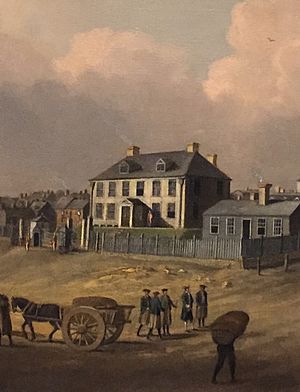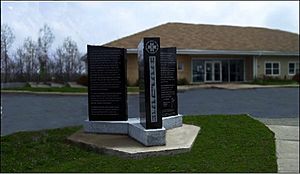Peregrine Hopson facts for kids

Peregrine Thomas Hopson (born June 5, 1696 – died February 27, 1759) was an important British army officer. He served for many years in the 1700s and became a Major General. He was in charge of the 40th Regiment of Foot. Hopson also commanded the British forces in Louisbourg from 1746 to 1749. Later, he became the Governor of Nova Scotia. He also led a big army trip to the West Indies during the Seven Years' War, where he passed away.
Many people remember Hopson for signing the Peace Treaty of 1752. This treaty was created by Edward Cornwallis with the Mi'kmaq chief Jean-Baptiste Cope. This treaty, along with others, is celebrated every year in Nova Scotia on Treaty Day.
Contents
Early Life and Military Career
Peregrine Hopson was born on June 5, 1696. He was the second son of Vice Admiral Sir Thomas Hopsonn. He first joined the Royal Marines in 1703. Later, he moved to the British Army. By 1743, he had become a Lieutenant Colonel. He spent much of his early career serving in Gibraltar.
Louisbourg Commander (1746-1749)
In the spring of 1746, Hopson arrived in Louisbourg, Nova Scotia. He brought more soldiers to help the British troops already there. The British had only captured Louisbourg from the French the year before. From 1747 to 1749, Hopson was the commander of the town. Louisbourg was given back to France as part of the Treaty of Aix-la-Chapelle. On July 12, 1749, Hopson officially handed the town back to the French army.
Governor of Nova Scotia (1752-1754)

During Father Le Loutre's War, Hopson served as the Governor of Nova Scotia. He was governor from 1752 to 1754. His office was in Halifax, the British capital. He worked to stop raids by the Mi'kmaq and Acadians. At the same time, he kept good relations with the French in Louisbourg and Quebec.
Edward Cornwallis created the Treaty of 1752. Hopson and Jean-Baptiste Cope signed this important agreement. After this, Hopson sent a group of people on a trip. This trip led to the Attack at Isle Madame. Because of this event, Chief Cope decided to end the treaty.
Seven Years' War (1756-1759)
Helping in Canada
When a new war with France began in 1756, Hopson returned to Halifax. He helped organize how Britain would respond to a possible French attack. He also played a part in the Great Upheaval. This was when many French-speaking people were moved from Nova Scotia. After this, he went back home to Britain. He was not chosen to lead the big British effort to capture Louisbourg in 1758.
Expedition to the West Indies
Instead, Hopson was chosen to lead a large military trip to the West Indies. This campaign was a key part of William Pitt's plan to win the war. Pitt wanted to capture rich French colonies in the Caribbean. King George II especially liked the idea of Hopson leading this mission. However, Pitt wanted one of his own chosen officers, John Barrington, to be second-in-command.
Hopson sailed from Portsmouth in 1758 with 9,000 soldiers. Once they were in the West Indies, the British used Barbados as a base. From there, they planned to attack two main French islands: Martinique and Guadeloupe. The British tried to capture Martinique, but they failed. Many soldiers were hurt, and more and more became sick. So, the British had to change their plans and focus on Guadeloupe.
As they tried to capture Guadeloupe, many British soldiers got sick. About 1,500 men quickly became ill. Hopson also caught a tropical disease and died in February 1759. After his death, John Barrington took command of the forces. Two months later, Barrington successfully captured Guadeloupe.

